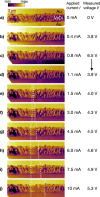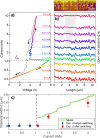Mott resistive switching initiated by topological defects
- PMID: 39482287
- PMCID: PMC11527880
- DOI: 10.1038/s41467-024-53726-z
Mott resistive switching initiated by topological defects
Abstract
Avalanche resistive switching is the fundamental process that triggers the sudden change of the electrical properties in solid-state devices under the action of intense electric fields. Despite its relevance for information processing, ultrafast electronics, neuromorphic devices, resistive memories and brain-inspired computation, the nature of the local stochastic fluctuations that drive the formation of metallic regions within the insulating state has remained hidden. Here, using operando X-ray nano-imaging, we have captured the origin of resistive switching in a V2O3-based device under working conditions. V2O3 is a paradigmatic Mott material, which undergoes a first-order metal-to-insulator phase transition together with a lattice transformation that breaks the threefold rotational symmetry of the rhombohedral metallic phase. We reveal a new class of volatile electronic switching triggered by nanoscale topological defects appearing in the shear-strain based order parameter that describes the insulating phase. Our results pave the way to the use of strain engineering approaches to manipulate such topological defects and achieve the full dynamical control of the electronic Mott switching. Topology-driven, reversible electronic transitions are relevant across a broad range of quantum materials, comprising transition metal oxides, chalcogenides and kagome metals.
© 2024. The Author(s).
Conflict of interest statement
The authors declare no competing interests.
Figures




References
-
- Tokura, Y., Kawasaki, M. & Nagaosa, N. Emergent functions of quantum materials. Nat. Phys.13, 1056–1068 (2017).
-
- Yang, Z., Ko, C. & Ramanathan, S. Oxide electronics utilizing ultrafast metal-insulator transitions. Annu. Rev. Mater. Res.41, 337–367 (2011).
-
- Zhang, J. & Averitt, R. D. Dynamics and control in complex transition metal oxides. Annu. Rev. Mater. Res.44, 19–43 (2014).
-
- Basov, D., Averitt, R. & Hsieh, D. Towards properties on demand in quantum materials. Nat. Mater.16, 1077–1088 (2017). - PubMed
Grants and funding
- 2020JLZ52N 003/Ministero dell'Istruzione, dell'Università e della Ricerca (Ministry of Education, University and Research)
- 20172H2SC4 005/Ministero dell'Istruzione, dell'Università e della Ricerca (Ministry of Education, University and Research)
- 20172H2SC4 005/Ministero dell'Istruzione, dell'Università e della Ricerca (Ministry of Education, University and Research)
- 2020JLZ52N 003/Ministero dell'Istruzione, dell'Università e della Ricerca (Ministry of Education, University and Research)
- 2020JLZ52N 003/Ministero dell'Istruzione, dell'Università e della Ricerca (Ministry of Education, University and Research)
- 20172H2SC4 005/Ministero dell'Istruzione, dell'Università e della Ricerca (Ministry of Education, University and Research)
- 20228YCYY7/European Commission (EC)
- 20228YCYY7/European Commission (EC)
- 20228YCYY7/European Commission (EC)
- ECoSOx-ECLIPSE/Ministry of Economy and Competitiveness | Agencia Estatal de Investigación (Spanish Agencia Estatal de Investigación)
- PRE2020-092625/Ministry of Economy and Competitiveness | Agencia Estatal de Investigación (Spanish Agencia Estatal de Investigación)
- CEX2020-001039-S/Ministry of Economy and Competitiveness | Agencia Estatal de Investigación (Spanish Agencia Estatal de Investigación)
- ECoSOx-ECLIPSE/Ministry of Economy and Competitiveness | Agencia Estatal de Investigación (Spanish Agencia Estatal de Investigación)
- CEX2020-001039-S/Ministry of Economy and Competitiveness | Agencia Estatal de Investigación (Spanish Agencia Estatal de Investigación)
- C14/21/083/KU Leuven (Katholieke Universiteit Leuven)
- iBOF/21/084/KU Leuven (Katholieke Universiteit Leuven)
- KAC24/18/056/KU Leuven (Katholieke Universiteit Leuven)
- C14/17/080/KU Leuven (Katholieke Universiteit Leuven)
- C14/21/083/KU Leuven (Katholieke Universiteit Leuven)
- iBOF/21/084/KU Leuven (Katholieke Universiteit Leuven)
- KAC24/18/056/KU Leuven (Katholieke Universiteit Leuven)
- C14/17/080/KU Leuven (Katholieke Universiteit Leuven)
- C14/21/083/KU Leuven (Katholieke Universiteit Leuven)
- iBOF/21/084/KU Leuven (Katholieke Universiteit Leuven)
- KAC24/18/056/KU Leuven (Katholieke Universiteit Leuven)
- C14/17/080/KU Leuven (Katholieke Universiteit Leuven)
- C14/21/083/KU Leuven (Katholieke Universiteit Leuven)
- iBOF/21/084/KU Leuven (Katholieke Universiteit Leuven)
- KAC24/18/056/KU Leuven (Katholieke Universiteit Leuven)
- C14/17/080/KU Leuven (Katholieke Universiteit Leuven)
- AKUL/13/19/Fonds Wetenschappelijk Onderzoek (Research Foundation Flanders)
- AKUL/19/023/Fonds Wetenschappelijk Onderzoek (Research Foundation Flanders)
- AKUL/13/19/Fonds Wetenschappelijk Onderzoek (Research Foundation Flanders)
- AKUL/19/023/Fonds Wetenschappelijk Onderzoek (Research Foundation Flanders)
- AKUL/13/19/Fonds Wetenschappelijk Onderzoek (Research Foundation Flanders)
- AKUL/19/023/Fonds Wetenschappelijk Onderzoek (Research Foundation Flanders)
- AKUL/13/19/Fonds Wetenschappelijk Onderzoek (Research Foundation Flanders)
- AKUL/19/023/Fonds Wetenschappelijk Onderzoek (Research Foundation Flanders)
- Finanziamenti ponte per bandi esterni/Università Cattolica del Sacro Cuore (Catholic University of the Sacred Heart)
LinkOut - more resources
Full Text Sources

